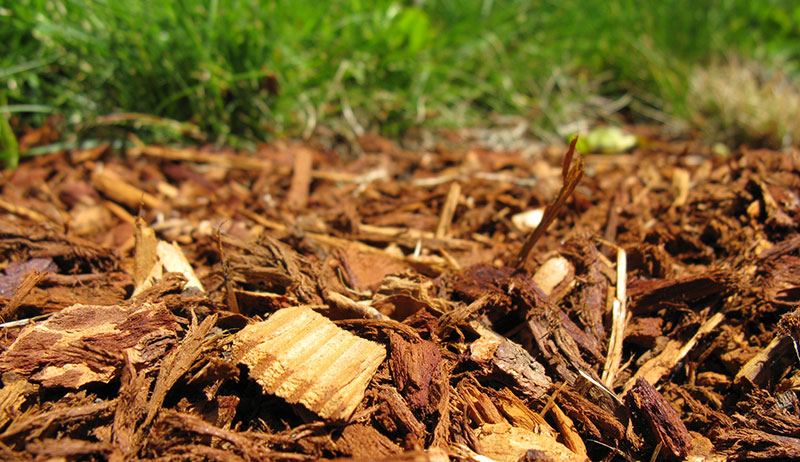
Do chickens have jobs? Perhaps most of us think of egg laying as their job. But from a chicken’s perspective, the bird’s main occupation is to scratch up the ground in a daylong foraging search for tasty food such as bugs, grubs, greens and seeds. All day long, it’s scratch-scratch-peck, scratch-scratch-peck. So anything we can do to generate more of those tasty morsels will not only please our hens but also trim our chicken feed expenses.
Now I don’t mind paying extra for organic chicken feed. But I’m always glad to find natural free sources of food for my hungry chickens. I especially like when that free food has other benefits.
A perfect example of saving money while boosting the foraging success rate of our chickens comes from throwing down a thick layer of wood chips in our chicken run.
Of course, the hens don’t eat the wood chips. But they do consume the soil-based critters that eat the wood chips: roly-polys, springtails and earthworms. Because chickens love to scratch the ground and devour whatever they find, I call this layer the “scratch and snack bar.”
My Method
To create this chicken-run snack bar, I spread a 6- to 8-inch layer of wood chips in the run two to three times a year. This has several advantages.
- First, it keeps the run from getting muddy.
- Second, the microbes that grow on the decomposing wood chips help the chicken poop break down faster; I don’t have to shovel any poop from the run.
- Third, the earthworms and soil insects that feed off the decomposing wood chips provide food and entertainment for the chickens in the run.
There is a key requirement for this to work: The run must remain open to the rain. If you have a roof over your chicken run, there won’t be enough moisture for the wood to decompose or to attract earthworms or insects. The chicken poop won’t break down either; you’ll have to scoop it up. That’s like having a toilet that won’t flush. It’s worthwhile—and much cheaper—to build a run without a roof, just make sure you cover the run with chicken wire to keep out aerial predators.
Free Chips
Anyone should be able to get free wood chips from a local tree-trimming company. After these workers cut branches, they run them through a large, noisy, gas-powered chipper/
shredder. The companies do that for two reasons: to make it easier to get a mountain of branches to fit into a dump truck and to reduce those branches to a form that’s easy to discard.
You, as a chicken keeper, must only look up the local tree trimmers or arborists in your area, then ask them to put you on the list to dump one or more truckloads of wood chips on your property. Many companies are happy to oblige because dumping on your property for free is a better deal than paying to dump the chips at a landfill.

A Few Chip Tips
Once you have received your wood chips, follow these bits of advice.
- Spread a tarp on the ground where you want the truck to dump the chips. Cleaning up those last several wheelbarrow loads of chips will go a lot faster from a tarp than scooping them off the ground. Simply lift up the edges of the tarp to consolidate the remaining pile to make it easier to load.
- Thin, blue plastic tarps are cheaper, but heavy-duty, brown plastic tarps are worth the extra cost.
- Use a long-handled, five-tine pitchfork to load the chips into the wheelbarrow, being careful not to poke pitchfork holes in your tarp.
- A long-handled gravel rake (which is to say, a hard rake) is the best tool for spreading wood chips.
- Autumn leaves and coffee chaff from local coffee roasters are other free sources of organic material to spread in the run. Because they’re not as dense, though, they won’t last as long as wood chips. You’ll spread them more frequently to keep the ground from getting muddy.
- If your chicken coop has a moat underneath (which is to say, the coop is raised off the ground), don’t spread wood chips there. The moat is a good dry place for hens to dig into the ground and make and take dust baths.
Make Room for Mushrooms
A colleague, Tradd Cotter, has had two local journalists visit his chickens. Both claim that his was the first chicken run that didn’t stink.
His secret was mushrooms—that and a layer of free hardwood chips applied periodically to his chicken run. Tradd uses king stropharia (Stropharia rugos-annulata) mushroom spore, added to the hardwood chips (not pine chips) to break down the chicken poop. Also called wine caps—because they are edible and taste great—they grow easily on wood chips and have the unique ability to quickly break down E. coli.
Tradd’s chicken run is never muddy, dusty or smelly. The E. coli doesn’t hurt the mushrooms, which the chickens don’t like to eat. So Tradd—and his wife and business partner Olga—get edible mushrooms as well as a clean chicken run.
Tradd makes his living from selling mushroom spores and wrote Organic Mushroom Farming and Mycoremediation. He knows what he’s talking about.
Readers can buy wine-cap spores from him at his website, www.mushroommountain.com. His book contains detailed instructions on growing wine-cap mushrooms on wood chips in the run or even on wood chips used as mulch in the garden.
The advantages to having wood chips in your chicken run are for you and your chickens. You get a cleaner chicken run and a lower food bill. Your hens get to do their jobs and eat some snacks.
This story originally appeared in the March/April 2018 issue of Chickens magazine.




